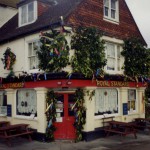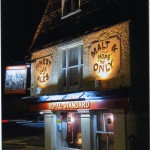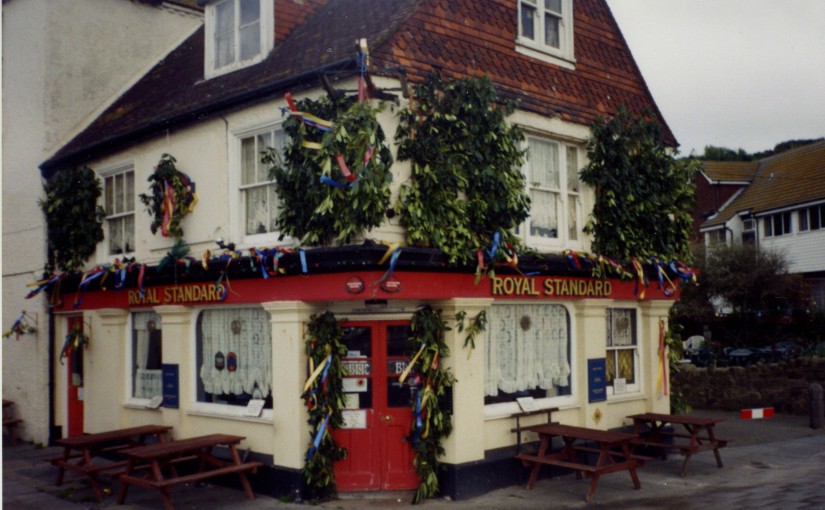By John Hodges
The first licence to sell beer was granted to the Royal Standard at sometime around 1822, at a time that predated the introduction of the new Beer House Act. This piece of sweeping legislation permitted any householder assessed to the poor rate, to obtain from the excise on a payment of two guineas, a licence to sell beer by retail from their dwelling house. It was this act, that was in force until 1869 when once again such matters reverted to the control of the licensing justices, that gave birth to the numerous Beer Houses that developed in the streets of Old Hastings and Central St.Leonards. Our first information concerning the building that subsequently became the Royal Standard comes from the deeds of the property, when in June 1707, a messuage in St Clement’s, Hastings was settled by Elizabeth Gawen (wife of Phillip Gawen the younger of Hastings, mariner) on her daughter Elizabeth (AMS5681/49/1). The daughter subsequently married Thomas Alisbury of All Saints, Hastings, mariner and had a son Phillip, a fisherman. In Aug 1786, Elizabeth, one of his daughters passed her share in the property to the other daughter Ann, wife of James Taught of Hastings, fisherman (AMS5681/49/7).
The next event in the history of the Royal Standard occurred when 12 East St (the neighbouring prop. to the West) was sold by William Shadwell of Hastings a gentleman in Mar 1794 (AMS5681/49/8) to Edward Raggett of Hastings cordwainer. By his will (AMS5681/49/9), dated May 1794, it passed to James Lock of Hastings, mariner and John Knight of Hastings, carpenter, whose descendants sold the property in Jan 1850 to Robert Kent of Hastings, boatbuilder (AMS5681/49/17). Meanwhile in Jan 1806, John Nash of Hastings, a mariner had contracted with James Taught (son of James and Ann) for the purchase of a newly-erected building, the earliest reference to the building that became the Royal Standard. This he sold in March 1822 to Richard Piper of Hastings, tapster (AMS5681/49/11-12), this is the earliest reference to a person connected with the licensed trade, a tapster being someone who drew and served ale.
In May 1853, Piper’s eldest son Richard sold ‘The Royal Standard’ for £495 to William Miskin Esq. and Richard Minshull Jones, both gentlemen of Southwark (AMS5681/49/20). Unfortunately, and prior to this sale, Richard Piper the Elder, and original publican, was lost at sea in 1833 on “The Four Sisters” (AMS5681/49/23). In Sep 1899, William Thomas Miskin of Eltham, Kent sold the Royal Standard and other pubs to Herbert Burfield of Park Hill, Hastings, an Old Town brewer located in Courthouse Street.
In Dec 1908, Burfields sold out to Smith and Co. of Lamberhurst (AMS5681/49/30), this sale included a tied estate of some twenty houses, whilst the Phoenix Brewery itself was retained for storage, together with an office at 46, High Street. However, in 1921 P. Allen Simpson the managing director of Smiths decided to retire and devote himself to farming, and this necessitated all of their sixty eight properties being offered for sale by auction in one lot. Unfortunately this offer failed to realise its reserve and a decision to sell the tied estate off in single lots was more successful, with just fourteen lots remaining unsold. One of the properties that was sold off was the Royal Standard, which was assigned to William Farrow in December 1922, who then took the opportunity two years later of also acquiring for £480, No. 12, East Street giving the pub its current size. The Royal Standard traded as a free house for about three years before William Farrow assigned the property to the Star Brewery Co. of Eastbourne in November 1925. There have been many landlords of the Royal Standard over the years, but probably the most unusual arrangement concerned the Bishop family who at various times between 1912 and 1956 held the licenses of not only the Royal Standard, but the Lord Nelson, the Rising Sun, the Kings Head at Ore, the Provincial Hotel in Havelock Road, and the Carlisle Hotel. The common denominator that ran through this multiple arrangement was the Star Brewery of Eastbourne, a strictly regional brewer owning a tied estate of forty three houses in the vicinity of Eastbourne and Hastings. But the Star Brewery, in keeping with nearly all such small undertakings, fell foul of Courage, Barclay, & Simmonds in 1965, who true to form closed the brewery in 1967, and absorbed the real prize of the tied estate into their own vast empire. This arrangement continued until the consequences of the Lord Young report in 1989 forced Courage as one of the then “big six” to divest themselves of all but two thousand of their tied properties. It was some time after this date that Shepherd Neame the Faversham brewer became the new owners of this old “fishing pub” and in who’s colours it still trades to this day.
The name Royal Standard is of great interest in itself. The modern Royal Standard of the United Kingdom, apart from minor changes, (notably to the form of harp used to represent Ireland), dates to the reign of Queen Victoria . Earlier Royal Standards of the United Kingdom incorporated the Arms of Hanover and of the Kingdom of France, representing the title of Elector (later King) of Hanover and the theoretical claim to the throne of France, a claim dropped in 1800. Since the Union of the Crowns in 1603, the composition of the Royal Standard has taken various forms. In today’s Standard there are four quarterings – two for England (three lions passant), one for Scotland (a lion rampant) and one for Ireland (a harp). Wales is not represented in the Royal Standard, as its special position as a Principality was recognised by the creation of the Prince of Wales long before the incorporation of the quarterings for Scotland and Ireland in the Royal Arms. Unlike the Union Flag, the Royal Standard is never flown at half-mast, even after the demise of the Crown, as there is always a sovereign on the throne. When this public house first adopted the name of the Royal Standard is not clear, as in earlier times most beer houses merely traded under the name of the owner or licensee. Certainly when it first sold alcoholic beverages in 1822 the banner of arms that would have appeared differed from the modern Standard as agnatic succession, prescribed under Salic Law, debarred Queen Victoria from becoming the Elector of Hanover, and as such reference to the Hanoverian throne was removed from the Royal Standard from 1837 onwards.
The Royal Standard is a handsome building – dating back about 300 years – situated in the picturesque old town area of Hastings close to the sea. It is traditionally furnished, with wooden floors, stripped back brick walls and inviting open fire.
You will find a friendly welcome in this community minded pub, from both the staff and locals, and it is a popular place with tourists in the summer; the pub has won awards for its well kept ales, you can enjoy a good old-fashioned game of shove hapenny – quite rare these days – and there is a small secluded garden with a heated, covered patio area for smokers.
The area has close associations with the services, with some interesting memorabilia on display depicting the forces and the fire brigade. The bar has a quirky illustration of the flooding to which the area is prone – historical flood levels in the pub are marked on the bar, the most recent being 2007.
Over the years the Royal Standard has been involved in many activities including a beach lease upon which the landlord’s net and rope shop provided facilities for his loyal customers, through to a distribution point for the allocation of tea to other pubs, and a thriving trade in groceries. Fishing has always played a large part in the life of the Royal Standard, never more so than when the “allowance system”, a method of credit based upon a crew’s earnings and settlement by the employing skipper on the appointed day, was prevalent with most Old Town traders. The Royal Standard has enjoyed a long and colourful life, but perhaps nothing to rival the colour and activities now associated with its role as a focal point for the annual Jack in the Green festival, when Hastings Old Town truly comes to life in this ancient celebration.
“Rye’s Own” March 2015
All articles, photographs and drawings on this web site are World Copyright Protected. No reproduction for publication without prior arrangement. Page
